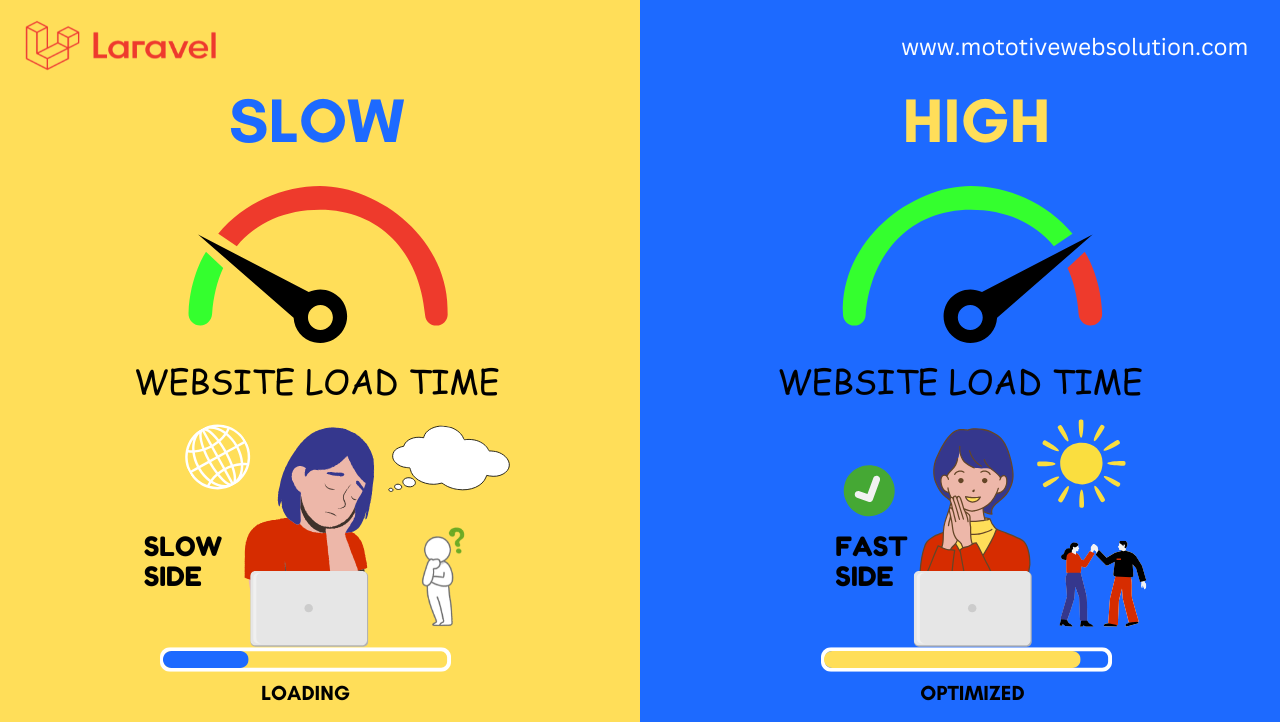
Introduction
Speed matters. A slow Laravel application can lead to poor SEO rankings, frustrated users, and lost conversions. While Laravel is a robust framework, performance bottlenecks can arise if not properly optimized.
In this article, I’ll share the exact techniques I used to cut Laravel page load times in half, ensuring faster response times and a seamless user experience.
1. Diagnosing Laravel Performance Issues

Before optimizing, the first step is diagnosing bottlenecks. These tools provide insights into what’s slowing down your Laravel application:
- Lighthouse – Evaluates web performance, SEO, and accessibility.
- Blackfire – Provides in-depth profiling for Laravel applications.
- Laravel Debugbar – Displays real-time memory usage, queries, and execution times.
By analyzing slow queries, inefficient caching, and excessive rendering times, we can focus on fixing the biggest issues.
2. Optimizing Database Queries
Inefficient database queries are a major cause of slow page load times. Here’s how I optimized mine:

✅ Eager Loading: Prevents the N+1 query problem by loading related data in a single query:
//Instead of this:$users = User::all();
foreach ($users as $user) {
echo $user->posts; // Multiple queries
}
//Use eager loading:$users = User::with('posts')->get();
✅ Indexing Database Tables: Adding indexes speeds up search queries significantly:
ALTER TABLE users ADD INDEX (email);
✅ Query Optimization: Using efficient queries reduces database load:
// Avoid selecting unnecessary columnsUser::select('id', 'name')->get();
3. Leveraging Caching for Faster Performance
Caching reduces database queries and speeds up response times. Here’s what worked for me:
- Route & View Caching:
php artisan config:cache
php artisan route:cache
- Query Caching: Store database results in cache:
$users = Cache::remember('users', 60, function () {
return User::all();
});
• Using Redis or Memcached:
Cache::store('redis')->put('key', 'value', 600);4. Reducing HTTP Requests & Optimizing Assets
Too many HTTP requests slow down page loads. I improved asset efficiency by:
✅ Minifying CSS & JS:
npm run prod
✅ Using Laravel Mix for Compilation:
mix.js('resources/js/app.js', 'public/js')
.sass('resources/sass/app.scss', 'public/css')
.version();✅ Enabling Gzip & Brotli Compression: Add this to your .htaccess file:
<IfModule mod_deflate.c>
AddOutputFilterByType DEFLATE text/html text/plain text/xml text/css text/javascript application/javascript
</IfModule>5. Using Queue Workers for Background Tasks
Blocking operations, such as sending emails or processing large tasks, should run in the background:
✅ Queue Jobs Example:
dispatch(new SendEmailJob($user));✅ Using Laravel Horizon for Monitoring Queues:
php artisan horizon6. Optimizing Server & Database Configuration

Server-side tuning made a huge impact on response times:
✅ Enable PHP Opcache:
opcache.enable=1
opcache.memory_consumption=128
opcache.max_accelerated_files=4000✅ Optimize MySQL Configurations:
innodb_buffer_pool_size=1G
query_cache_size=64M✅ Use a Load Balancer & Optimize Hosting:
- Choose high-performance hosting (e.g., DigitalOcean, AWS).
- Use CDNs like Cloudflare for asset delivery.
7. Enabling Lazy Loading & Code Optimization
Code improvements also contribute to faster response times:
✅Enable Lazy Loading to Reduce Excess Queries:
use Illuminate\Database\Eloquent\Model;
Model::preventLazyLoading();✅ Optimize Middleware & Routes:
// Use route groups to reduce redundant middleware
Route::middleware(['auth'])->group(function () {
Route::get('/dashboard', [DashboardController::class, 'index']);
});✅ Use Laravel Octane for High Performance:
composer require laravel/octane php artisan octane:start
Octane uses Swoole or RoadRunner to handle concurrent requests efficiently.
Conclusion
By applying these techniques, I successfully reduced Laravel page load times by 50%.
Key Takeaways:
✅ Profile before optimizing – Use tools like Blackfire & Debugbar.
✅ Optimize database queries – Use eager loading, indexes, and optimized queries.
✅ Leverage caching – Use Redis, query caching, and route caching.
✅ Minimize asset sizes & HTTP requests – Use Laravel Mix, minification, and compression.
✅ Offload background tasks – Use queues for emails, notifications, and logs.
✅ Fine-tune the server – Enable Opcache, optimize MySQL, and use a CDN.
✅ Adopt high-performance tools – Use Laravel Octane and lazy loading.
Continuous monitoring and proactive optimization ensure long-term speed and performance. Have you tried any of these techniques? Share your experience in the comments! 🚀

